Kutz M. Handbook of materials selection
Подождите немного. Документ загружается.


BIBLIOGRAPHY 923
59). A photographic negative, often a reduced image of an oversize master print
(up to 100
⫻), is applied to the workpiece and developed. Precise registry of
duplicate negatives on each side of the sheet is essential for accurately blanked
parts. Immersion or spray etching is used to remove the exposed material. The
chemicals used must be active on the workpiece, but inactive against the pho-
toresistant mask. The use of PCM is limited to thin materials—up to in. (1.5
1
––
16
mm).
16.31 Thermochemical Machining
Thermochemical machining (TCM) removes the workpiece material—usually
only burrs and fins—by exposure of the workpiece to hot, corrosive gases. The
process is sometimes called combustion machining, thermal deburring, or ther-
mal energy method (TEM). The workpiece is exposed for a very short time to
extremely hot gases, which are formed by detonating an explosive mixture. The
ignition of the explosive—usually hydrogen or natural gas and oxygen—creates
a transient thermal wave that vaporizes the burrs and fins. The main body of the
workpiece remains unaffected and relatively cool because of its low surface-to-
mass ratio and the shortness of the exposure to high temperatures.
REFERENCES
1. Society of Manufacturing Engineers, Tool and Manufacturing Engineers Handbook, Vol. 1, Ma-
chining, McGraw-Hill, New York, 1985.
2. Machining Data Handbook, 3rd ed., Machinability Data Center, Cincinnati, OH, 1980.
3. Metals Handbook, 8th ed., Vol. 3, Machining American Society for Metals, Metals Park, OH,
1985.
4. R. LeGrand (ed.), American Machinist’s Handbook, 3rd ed., McGraw-Hill, New York, 1973.
5. Machinery’s Handbook, 21st ed., Industrial Press, New York, 1979.
6. Machinery Handbook, Vol. 2, Machinability Data Center, Cincinnati, Department of Defense,
1983.
BIBLIOGRAPHY
Alting, L., Manufacturing Engineering Processes, Marcel Dekker, New York, 1982.
Amstead, B. H., P. F. Ostwald, and M. L. Begeman, Manufacturing Processes, 8th ed., Wiley, New
York, 1988.
DeGarmo, E. P., J. T. Black, and R. A. Kohser, Material and Processes in Manufacturing, 7th ed.,
Macmillan, New York, 1988.
Doyle, L. E., G. F. Schrader, and M. B. Singer, Manufacturing Processes and Materials for Engineers,
3rd ed., Prentice-Hill, Englewood Cliffs, NJ, 1985.
Kalpakjian, S., Manufacturing Processes for Engineering Materials, Addison-Wesley, Reading, MA,
1994.
Kronenberg, M., Machining Science and Application, Pergamon, London, 1966.
Lindberg, R. A., Processes and Materials of Manufacture, 2nd ed., Allyn and Bacon, Boston, MA,
1977.
Moore, H. D., and D. R. Kibbey, Manufacturing Materials and Processes, 3rd ed., Wiley, New York,
1982.
Niebel, B. W., and A. B. Draper, Product Design and Process Engineering, McGraw-Hill, New York,
1974.
Schey, J. A., Introduction to Manufacturing Processes, McGraw-Hill, New York, 1977.
Shaw, M. C., Metal Cutting Principles, Oxford University Press, Oxford, 1984.
Zohdi, M. E., ‘‘Statistical Analysis, Estimation and Optimization in the Grinding Process,’’ ASME
Transactions, 1973, Paper No. 73-DET-3.

925
CHAPTER 31
METAL FORMING, SHAPING,
AND CASTING
Magd E. Zohdi
Dennis B. Webster
Department of Industrial and Manufacturing Systems Engineering
Louisiana State University
Baton Rouge, Louisiana
William E. Biles
Department of Industrial Engineering
University of Louisville
Louisville, Kentucky
1 INTRODUCTION 925
2 HOT-WORKING PROCESSES 926
2.1 Classification of
Hot-Working Processes 927
2.2 Rolling 927
2.3 Forging 929
2.4 Extrusion 932
2.5 Drawing 933
2.6 Spinning 935
2.7 Pipe Welding 937
2.8 Piercing 938
3 COLD-WORKING PROCESSES 939
3.1 Classification of
Cold-Working Operations 939
3.2 Squeezing Processes 940
3.3 Bending 942
3.4 Shearing 944
3.5 Drawing 947
4 METAL CASTING AND
MOLDING PROCESSES 949
4.1 Sand Casting 949
4.2 Centrifugal Casting 951
4.3 Permanent-Mold Casting 953
4.4 Plaster-Mold Casting 955
4.5 Investment Casting 956
5 PLASTIC-MOLDING
PROCESSES 957
5.1 Injection Molding 957
5.2 Coinjection Molding 957
5.3 Rotomolding 957
5.4 Expandable-Bead Molding 957
5.5 Extruding 958
5.6 Blow Molding 958
5.7 Thermoforming 958
5.8 Reinforced-Plastic
Molding 958
5.9 Forged-Plastic Parts 958
6 POWDER METALLURGY 959
6.1 Properties of P / M
Products 959
7 SURFACE TREATMENT 960
7.1 Cleaning 960
7.2 Coatings 963
7.3 Chemical Conversions 966
BIBLIOGRAPHY 967
1 INTRODUCTION
Metal-forming processes use a remarkable property of metals—their ability to
flow plastically in the solid state without concurrent deterioration of properties.
Reprinted from Mechanical Engineers’ Handbook, 2nd ed., Wiley, New York, 1998, by permission
of the publisher.
HandbookofMaterialsSelection.EditedbyMyerKutz
Copyright Ó 2002 John Wiley & Sons, Inc., NewYork.

926 METAL FORMING, SHAPING, AND CASTING
Fig. 1 Metal-forming processes.
Moreover, by simply moving the metal to the desired shape, there is little or no
waste. Figure 1 shows some of the metal-forming processes. Metal-forming pro-
cesses are classified into two categories: hot-working processes and cold-
working processes.
2 HOT-WORKING PROCESSES
Hot working is defined as the plastic deformation of metals above their recrys-
tallization temperature. Here it is important to note that the crystallization tem-
perature varies greatly with different materials. Lead and tin are hot worked at
room temperature, while steels require temperatures of 2000
⬚F (1100⬚C). Hot
working does not necessarily imply high absolute temperatures.
Hot working can produce the following improvements:

2 HOT-WORKING PROCESSES 927
1. Production of randomly oriented, spherical-shaped grain structure, which
results in a net increase not only in the strength but also in ductility and
toughness.
2. The reorientation of inclusions or impurity material in metal. The im-
purity material often distorts and flows along with the metal.
This material, however, does not recrystallize with the base metal and often
produces a fiber structure. Such a structure clearly has directional properties,
being stronger in one direction than in another. Moreover, an impurity originally
oriented so as to aid crack movement through the metal is often reoriented into
a ‘‘crack-arrestor’’ configuration perpendicular to crack propagation.
2.1 Classification of Hot-Working Processes
The most obvious reason for the popularity of hot working is that it provides
an attractive means of forming a desired shape. Some of the hot-working pro-
cesses that are of major importance in modern manufacturing are
1. Rolling
2. Forging
3. Extrusion and upsetting
4. Drawing
5. Spinning
6. Pipe welding
7. Piercing
2.2 Rolling
Hot rolling (Fig. 2) consists of passing heated metal between two rolls that
revolve in opposite directions, the space between the rolls being somewhat less
than the thickness of the entering metal. Many finished parts, such as hot-rolled
structural shapes, are completed entirely by hot rolling. More often, however,
hot-rolled products, such as sheets, plates, bars, and strips, serve as input ma-
terial for other processes, such as cold forming or machining.
In hot rolling, as in all hot working, it is very important that the metal be
heated uniformly throughout to the proper temperature, a procedure known as
soaking. If the temperature is not uniform, the subsequent deformation will also
be nonuniform, the hotter exterior flowing in preference to the cooler and, there-
fore, stronger, interior. Cracking, tearing, and associated problems may result.
Isothermal Rolling
The ordinary rolling of some high-strength metals, such as titanium and stainless
steels, particularly in thicknesses below about 0.150 in. (3.8 mm), is difficult
because the heat in the sheet is transferred rapidly to the cold and much more
massive rolls. This has been overcome by isothermal rolling. Localized heating
is accomplished in the area of deformation by the passage of a large electrical
current between the rolls, through the sheet. Reductions up to 90% per roll have
been achieved. The process usually is restricted to widths below 2 in. (50 mm).
The rolling strip contact length is given by
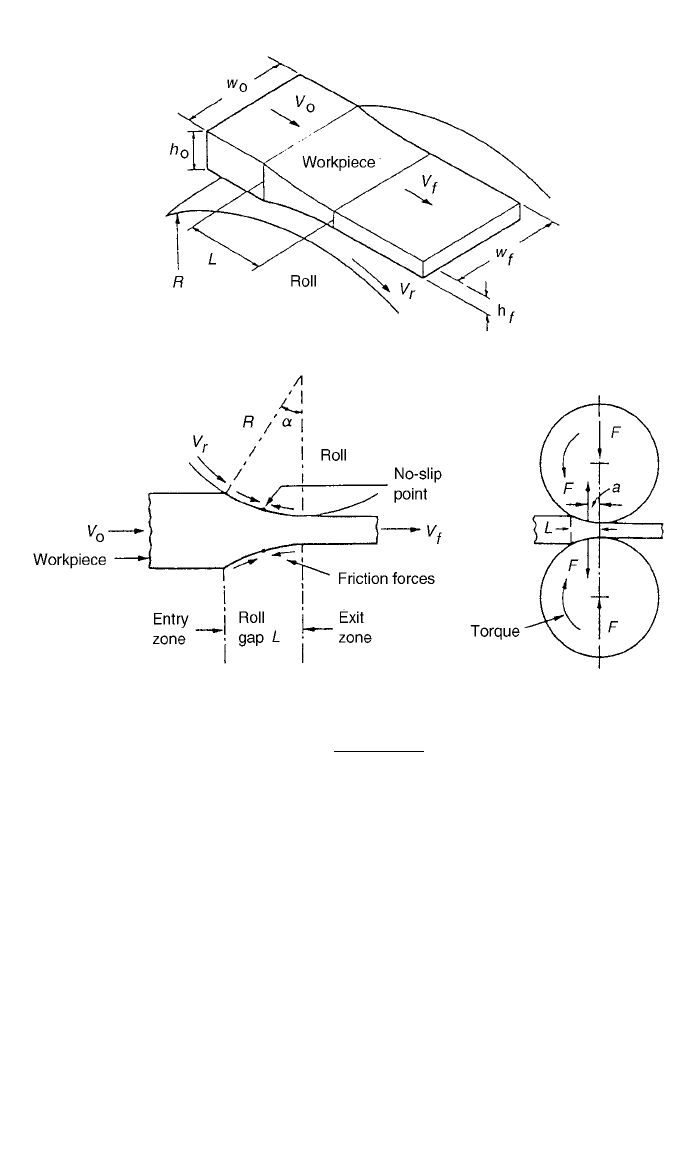
928 METAL FORMING, SHAPING, AND CASTING
Fig. 2 Hot rolling.
L ⯝兹R(h ⫺ h)
0
where R ⫽ roll radius
h
0
⫽ original strip thickness
h
⫽ reduced thickness
The roll force F is calculated by
F
⫽ LwY (1)
avg
where w ⫽ width
Y
avg
⫽ average true stress
Figure 3 gives the true stress for different material at the true stress
. The true
stress
is given by

2 HOT-WORKING PROCESSES 929
Fig. 3 True stress–true strain curves.
h
0
⫽ ln
冉冊
h
2
FLN
Roll/Power ⫽ kW (2)
60,000
where F
⫽ newtons
L
⫽ meters
N
⫽ rev per min
2
FLN
Power ⫽ hp (3)
33,000
or
where F
⫽ lb
L
⫽ ft
2.3 Forging
Forging is the plastic working of metal by means of localized compressive forces
exerted by manual or power hammers, presses, or special forging machines.
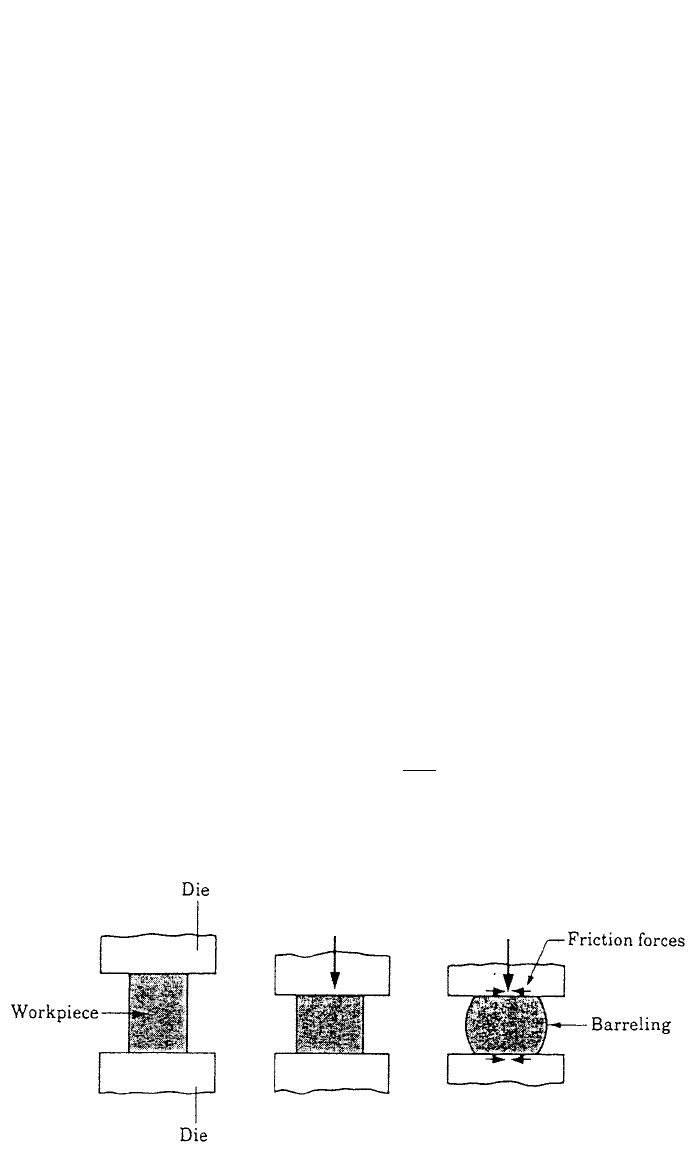
930 METAL FORMING, SHAPING, AND CASTING
Fig. 4 Open-die hammer forging.
Various types of forging have been developed to provide great flexibility,
making it economically possible to forge a single piece or to mass produce
thousands of identical parts. The metal may be
1. Drawn out, increasing its length and decreasing its cross section
2. Upset, increasing the cross section and decreasing the length, or
3. Squeezed in closed impression dies to produce multidirectional flow
The state of stress in the work is primarily uniaxial or multiaxial compression.
The common forging processes are
1. Open-die hammer
2. Impression-die drop forging
3. Press forging
4. Upset forging
5. Roll forging
6. Swaging
Open-Die Hammer Forging
Open-die forging, (Fig. 4) does not confine the flow of metal, the hammer and
anvil often being completely flat. The desired shape is obtained by manipulating
the workpiece between blows. Specially shaped tools or a slightly shaped die
between the workpiece and the hammer or anvil are used to aid in shaping
sections (round, concave, or convex), making holes, or performing cutoff oper-
ations.
The force F required for an open-die forging operation on a solid cylindrical
piece can be calculated by
2
r
2
F ⫽ Y
r 1 ⫹ (4)
冉冊
ƒ
3h
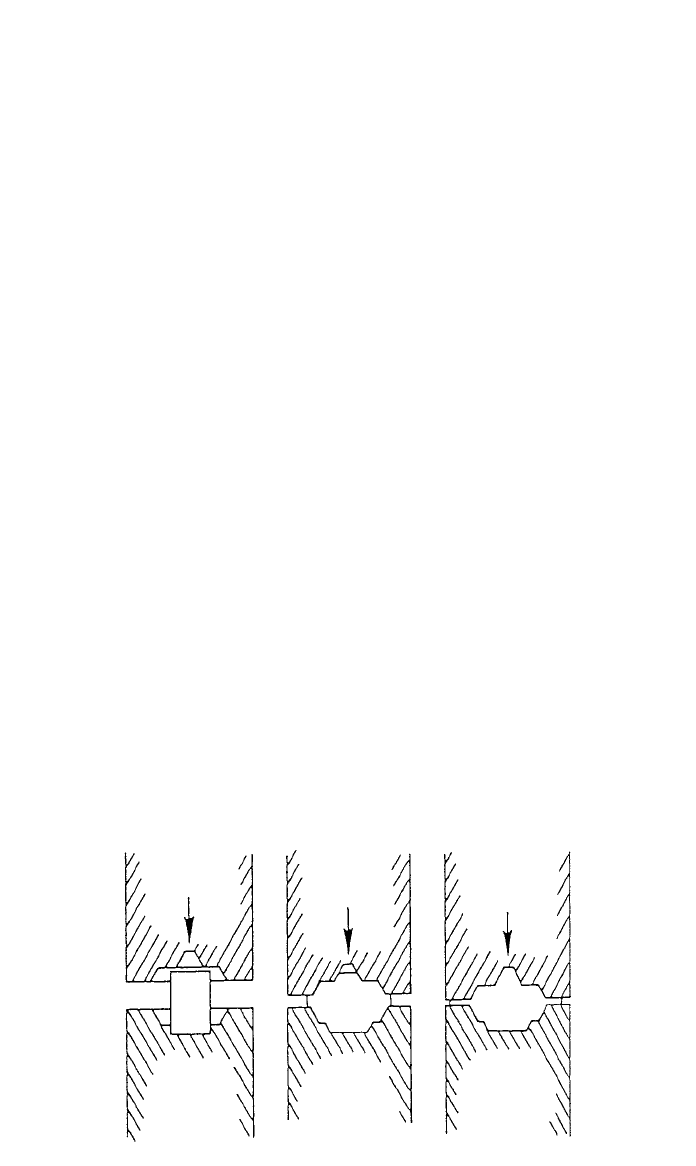
2 HOT-WORKING PROCESSES 931
Fig. 5 Impression-die drop forging.
where Y
ƒ
⫽ flow stress at the specific [ ⫽ ln(h
0
/h)]
⫽ coefficient of friction
r and h
⫽ radius and height of workpiece
Impression-Die Drop Forging
In impression-die or closed-die drop forging (Fig. 5), the heated metal is placed
in the lower cavity of the die and struck one or more blows with the upper die.
This hammering causes the metal to flow so as to fill the die cavity. Excess
metal is squeezed out between the die faces along the periphery of the cavity to
form a flash. When forging is completed, the flash is trimmed off by means of
a trimming die.
The forging force F required for impression-die forging can be estimated by
F
⫽ KY A (5)
ƒ
where K ⫽ multiplying factor (4–12) depending on the complexity of the shape
Y
ƒ
⫽ flow stress at forging temperature
A
⫽ projected area, including flash
Press Forging
Press forging employs a slow-squeezing action that penetrates throughout the
metal and produces a uniform metal flow. In hammer or impact forging, metal
flow is a response to the energy in the hammer–workpiece collision. If all the
energy can be dissipated through flow of the surface layers of metal and ab-
sorption by the press foundation, the interior regions of the workpiece can go
undeformed. Therefore, when the forging of large sections is required, press
forging must be employed.
Upset Forging
Upset forging involves increasing the diameter of the end or central portion of
a bar of metal by compressing its length. Upset-forging machines are used to
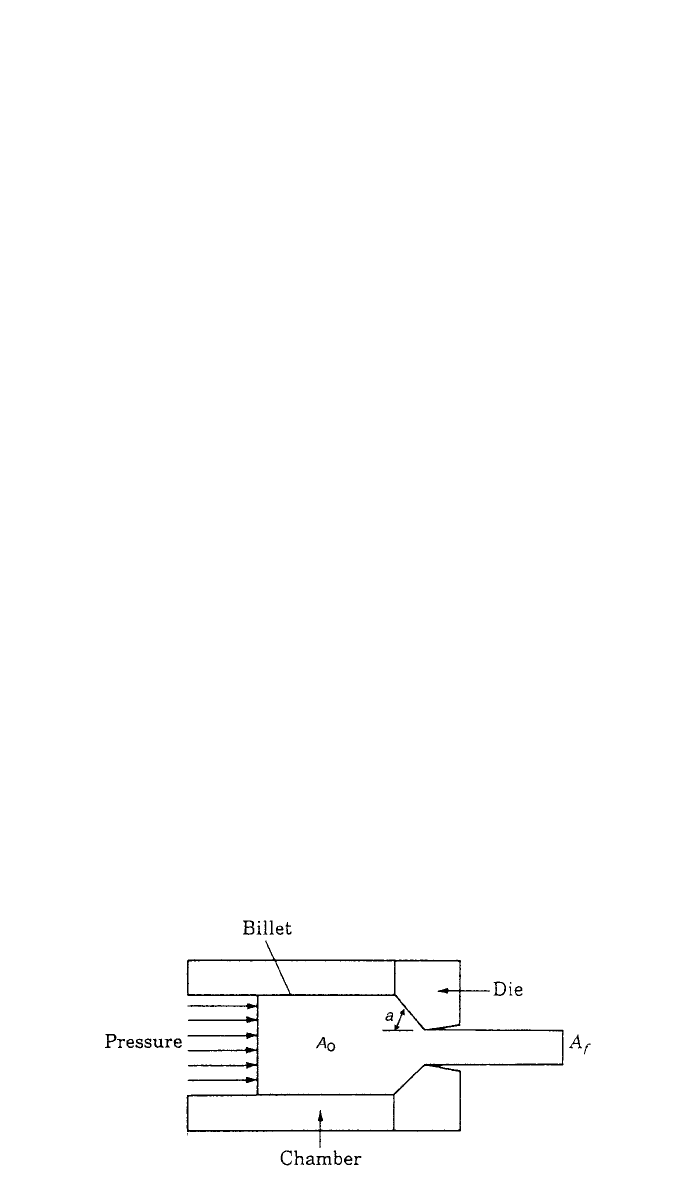
932 METAL FORMING, SHAPING, AND CASTING
Fig. 6 Extrusion process.
forge heads on bolts and other fasteners, valves, couplings, and many other small
components.
Roll Forging
Roll forging, in which round or flat bar stock is reduced in thickness and in-
creased in length, is used to produce such components as axles, tapered levers,
and leaf springs.
Swaging
Swaging involves hammering or forcing a tube or rod into a confining die to
reduce its diameter, the die often playing the role of the hammer. Repeated blows
cause the metal to flow inward and take the internal form of the die.
2.4 Extrusion
In the extrusion process (Fig. 6), metal is compressively forced to flow through
a suitably shaped die to form a product with reduced cross section. Although it
may be performed either hot or cold, hot extrusion is employed for many metals
to reduce the forces required, to eliminate cold-working effects, and to reduce
directional properties. The stress state within the material is triaxial compression.
Lead, copper, aluminum, and magnesium, and alloys of these metals, are
commonly extruded, taking advantage of the relatively low yield strengths and
extrusion temperatures. Steel is more difficult to extrude. Yield strengths are
high and the metal has a tendency to weld to the walls of the die and confining
chamber under the conditions of high temperature and pressures. With the de-
velopment and use of phosphate-based and molten glass lubricants, substantial
quantities of hot steel extrusions are now produced. These lubricants adhere to
the billet and prevent metal-to-metal contact throughout the process.
Almost any cross-section shape can be extruded from the nonferrous metals.
Hollow shapes can be extruded by several methods. For tubular products, the
stationary or moving mandrel process is often employed. For more complex
internal cavities, a spider mandrel or torpedo die is used. Obviously, the cost for
hollow extrusions is considerably greater than for solid ones, but a wide variety
of shapes can be produced that cannot be made by any other process.
The extrusion force F can be estimated from the formula
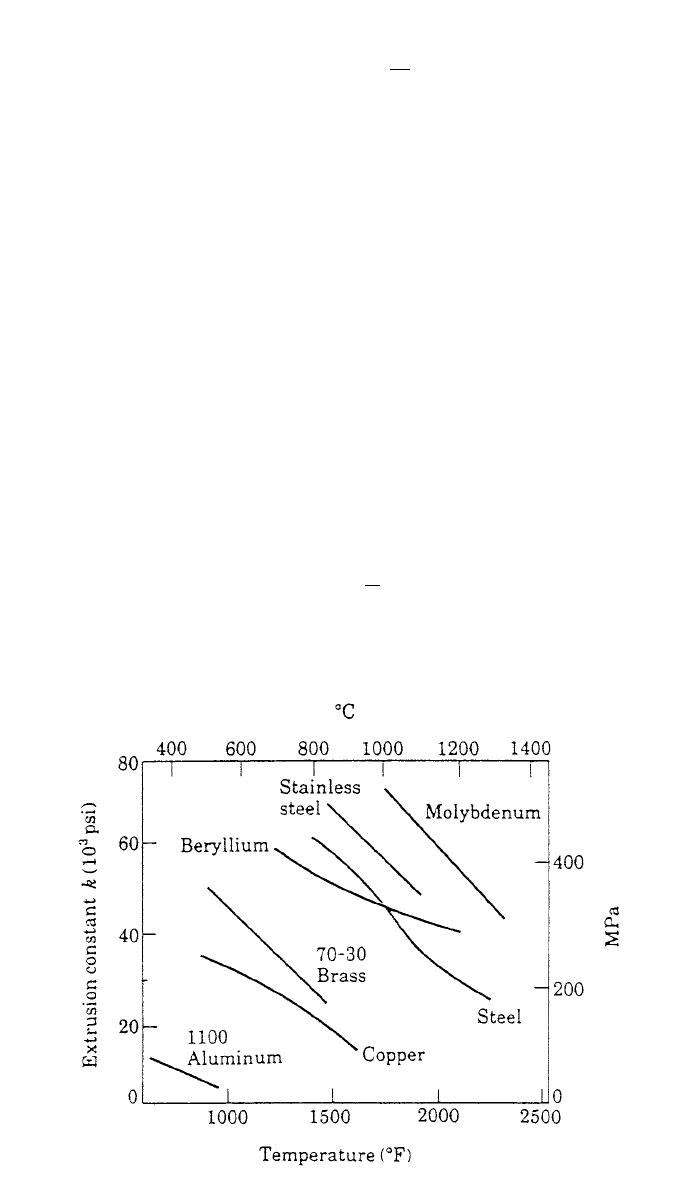
2 HOT-WORKING PROCESSES 933
Fig. 7 Extrusion constant k.
A
0
F ⫽ Akln (6)
冉冊
0
A
where k
⫽ extrusion constant depends on material and temperature (see Fig. 7)
A
0
⫽ billet area
A
ƒ
⫽ finished extruded area
2.5 Drawing
Drawing (Fig. 8) is a process for forming sheet metal between an edge-opposing
punch and a die (draw ring) to produce a cup, cone, box, or shell-like part. The
work metal is bent over and wrapped around the punch nose. At the same time,
the outer portions of the blank move rapidly toward the center of the blank until
they flow over the die radius as the blank is drawn into the die cavity by the
punch. The radial movement of the metal increases the blank thickness as the
metal moves toward the die radius; as the metal flows over the die radius, this
thickness decreases because of the tension in the shell wall between the punch
nose and the die radius and (in some instances) because of the clearance between
the punch and the die.
The force (load) required for drawing a round cup is expressed by the fol-
lowing empirical equation:
D
L ⫽
dtS ⫺ k (7)
冉冊
d
